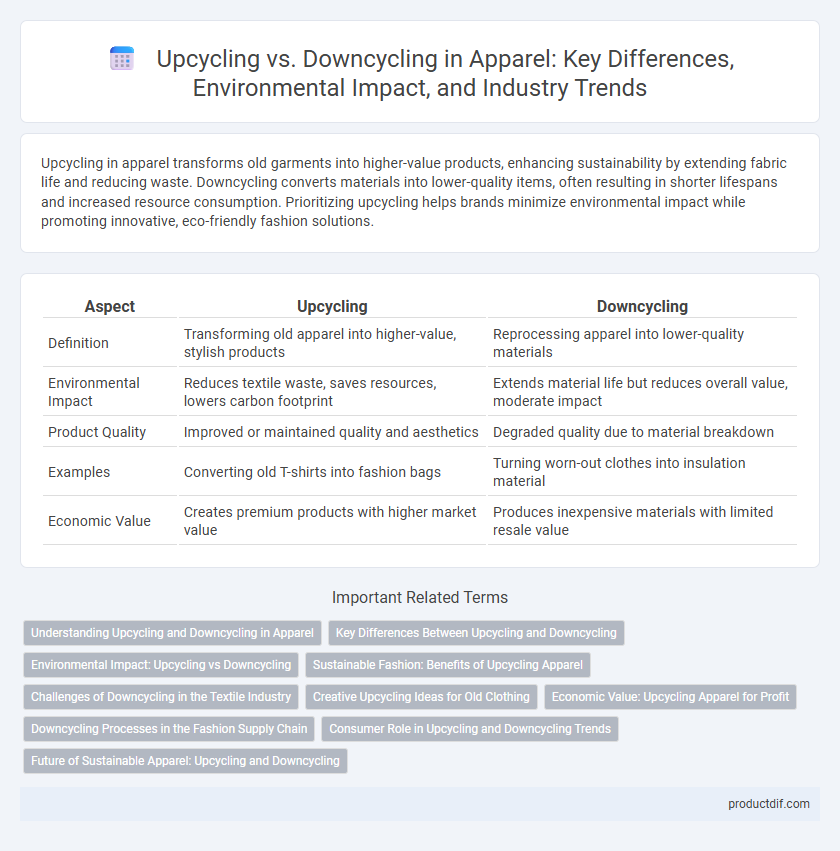Upcycling in apparel transforms old garments into higher-value products, enhancing sustainability by extending fabric life and reducing waste. Downcycling converts materials into lower-quality items, often resulting in shorter lifespans and increased resource consumption. Prioritizing upcycling helps brands minimize environmental impact while promoting innovative, eco-friendly fashion solutions.
Table of Comparison
| Aspect | Upcycling | Downcycling |
|---|---|---|
| Definition | Transforming old apparel into higher-value, stylish products | Reprocessing apparel into lower-quality materials |
| Environmental Impact | Reduces textile waste, saves resources, lowers carbon footprint | Extends material life but reduces overall value, moderate impact |
| Product Quality | Improved or maintained quality and aesthetics | Degraded quality due to material breakdown |
| Examples | Converting old T-shirts into fashion bags | Turning worn-out clothes into insulation material |
| Economic Value | Creates premium products with higher market value | Produces inexpensive materials with limited resale value |
Understanding Upcycling and Downcycling in Apparel
Upcycling in apparel involves transforming used or discarded clothing into higher-quality or more valuable products, preserving material integrity and extending garment lifespan. Downcycling refers to repurposing textiles into lower-grade materials, such as insulation or cleaning rags, reducing fabric quality and utility. Understanding these processes highlights the environmental impact and sustainability potential within the fashion industry's circular economy.
Key Differences Between Upcycling and Downcycling
Upcycling in apparel transforms old garments into higher-quality or more valuable items by enhancing materials or design, promoting sustainability and creativity. Downcycling, conversely, breaks down textiles into lower-quality fibers or products with reduced value and durability, often used for insulation or cleaning rags. Key differences include the end product's value, material integrity, and environmental impact, with upcycling extending garment life more effectively than downcycling.
Environmental Impact: Upcycling vs Downcycling
Upcycling in apparel transforms old garments into higher-value products, significantly reducing textile waste and lowering carbon emissions by minimizing the need for new raw materials. Downcycling breaks fabrics into lower-quality materials, which often leads to eventual landfill disposal and releases harmful chemicals during degradation. Choosing upcycling enhances sustainability by extending textile life cycles and conserving resources, whereas downcycling offers limited environmental benefits due to material degradation and reduced reuse potential.
Sustainable Fashion: Benefits of Upcycling Apparel
Upcycling apparel transforms discarded textiles into higher-value fashion items, reducing waste and minimizing environmental impact compared to downcycling, which degrades material quality. This sustainable fashion approach conserves resources, decreases textile landfill contributions, and promotes creative garment design with unique appeal. Emphasizing upcycling supports circular economy principles by extending fabric life cycles and fostering eco-conscious consumer choices.
Challenges of Downcycling in the Textile Industry
Downcycling in the textile industry often leads to reduced fiber quality, limiting the potential for high-value applications and contributing to faster material degradation. The process commonly produces lower-grade materials such as insulation or cleaning rags, which undermines the goal of true sustainability and circularity. Challenges include inefficient separation of blended fibers and contamination, resulting in costly processing and diminished economic viability for textile manufacturers.
Creative Upcycling Ideas for Old Clothing
Creative upcycling ideas for old clothing transform worn fabrics into unique fashion pieces like patchwork jackets, embellished denim, and reimagined skirts, preserving fabric quality and reducing waste. Techniques such as embroidery, fabric painting, and cutting garments into new shapes enhance garment longevity while showcasing personal style. These innovative approaches contribute to sustainable apparel by minimizing textile landfill contributions and promoting circular fashion principles.
Economic Value: Upcycling Apparel for Profit
Upcycling apparel transforms old or discarded clothing into higher-quality or more valuable products, significantly enhancing economic value by creating unique, market-demand items. This process often yields higher profit margins compared to downcycling, which repurposes materials into lower-value products, thus reducing overall revenue potential. By fostering brand differentiation and sustainability appeal, upcycled fashion drives consumer willingness to pay premium prices, boosting profitability in the competitive apparel market.
Downcycling Processes in the Fashion Supply Chain
Downcycling in the fashion supply chain involves converting old or discarded textiles into lower-quality materials, such as insulation, cleaning rags, or stuffing, significantly reducing their value and usability. This process often breaks down fibers, leading to diminished durability and limited recycling potential compared to upcycling, which retains or enhances fabric quality. Fashion brands increasingly rely on downcycling to manage textile waste, but it highlights the need for innovations in fiber regeneration to support circular economy goals.
Consumer Role in Upcycling and Downcycling Trends
Consumers play a decisive role in the apparel industry's upcycling and downcycling trends by choosing garments that extend product life cycles and reduce textile waste. Engaging in upcycling, they transform old clothing into higher-value pieces, promoting sustainability and reducing environmental impact. Alternatively, selecting downcycled products often leads to lower-quality materials repurposed for less valuable uses, emphasizing the need for consumer awareness to prioritize upcycling initiatives.
Future of Sustainable Apparel: Upcycling and Downcycling
Upcycling in apparel transforms discarded fabrics into higher-value products, reducing waste and preserving material quality, while downcycling breaks materials into lower-grade fibers, often resulting in shorter product lifespans. The future of sustainable apparel heavily relies on innovative upcycling techniques to extend garment life cycles and minimize environmental impact, promoting circular fashion economies. Advances in textile recycling technology and design-for-recyclability standards will further enhance the effectiveness of both upcycling and downcycling in reducing fashion industry waste.
Upcycling vs Downcycling Infographic

 productdif.com
productdif.com